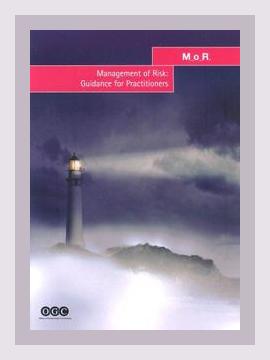Operations and Supply Chain ManagementProject Management
Introduction and Importance of Risk Management
The seminal book “Management of Risk: Guidance for Practitioners” by the Office of Government Commerce (OGC) is a cornerstone text in the field of Project Management, specifically focusing on the synthesis of risk management principles into organizational, project, and program contexts. The text is methodologically robust, integrating theoretical foundations with practical guidance and extensive real-world examples to enrich understanding and application.
Key Concepts and Definitions
- Definition of Risk:
- Risk is the combination of the probability of an event and its consequences.
- Example: If an IT project risks data breaches by 15%, and the consequence is severe loss of user trust, the risk must be addressed with high priority.
-
Action: Identify risks during the project planning phase.
-
Risk Management Framework:
- Emphasizes identifying, assessing, planning, implementing, and reviewing risks.
- Example: In a construction project, use a Risk Management framework to assess risks of labor strikes.
-
Action: Develop a risk register early in the project lifecycle.
-
Principles of Risk Management:
- Principles include: aligning risk management with organizational processes, fitting the context, and treating risk as an ongoing process.
- Example: A software development company aligns its risk management process with Agile methodologies.
- Action: Integrate risk management practices into regular team meetings.
Risk Management Process
- Identification:
- Methods like brainstorming, interviews, and checklists.
- Example: Use SWOT analysis for comprehensive risk identification in a marketing project.
-
Action: Conduct regular risk identification workshops.
-
Assessment:
- Using tools like risk matrices and qualitative/quantitative analysis.
- Example: Evaluate the impact and probability of supplier failures in manufacturing with a 5×5 risk matrix.
-
Action: Employ risk scoring to prioritize risks efficiently.
-
Planning:
- Includes risk response planning strategies such as avoidance, mitigation, transfer, and acceptance.
- Example: Choose to mitigate risk by increasing the project contingency budget for uncertain tasks.
-
Action: Document risk response strategies in the project plan.
-
Implementation:
- Execution of risk response plans, allocating resources and responsibilities.
- Example: Implement additional staff training to mitigate identified skill gaps in a tech project.
-
Action: Assign specific risk management tasks to team members.
-
Review and Reporting:
- Continuous monitoring and review of risks during all project phases.
- Example: Regularly update stakeholders about new risks in bi-weekly progress reports.
- Action: Schedule regular risk review sessions.
Roles and Responsibilities
- Risk Manager: Primary role in risk identification, analysis, and management.
- Example: A Risk Manager in a pharmaceutical firm leads efforts to identify regulatory compliance risks.
-
Action: Ensure the Risk Manager is involved in all planning meetings.
-
Project Manager: Integrates risk management into overall project delivery.
- Example: A Project Manager in an engineering project ensures risk management activities align with project milestones.
-
Action: Include risk management activities in the project timeline.
-
Stakeholders: Engage in risk identification and management.
- Example: Key business stakeholders in a financial project provide insights into market risk.
- Action: Engage stakeholders at each risk management stage.
Tools and Techniques
- Risk Registers: Central documentation of identified risks.
- Example: A comprehensive risk register for a hospital expansion project capturing financial, operational, and legal risks.
-
Action: Maintain and update the risk register consistently.
-
Risk Workshops: Collaborative platforms for risk identification and assessment.
- Example: Conducting a risk workshop involving cross-functional teams for a new product launch.
-
Action: Schedule and facilitate periodic risk workshops.
-
SWOT Analysis: Analyzing strengths, weaknesses, opportunities, and threats.
- Example: A transport company performs SWOT to understand internal and external risk factors.
-
Action: Utilize SWOT analysis at the project’s initiation phase.
-
Monte Carlo Simulation: Statistical technique for risk quantification.
- Example: Use Monte Carlo Simulation in a finance project to predict project cost overruns under various scenarios.
- Action: Acquire necessary software tools to perform simulations.
Case Studies and Examples
- IT Infrastructure Project:
- Identification: Use historical data to identify risks.
- Assessment: Employ qualitative risk assessment techniques.
- Planning: Develop contingency plans for potential cyber-attacks.
- Implementation: Regular security updates and training.
-
Review: Continuous monitoring through automated risk detection tools.
-
Construction Project:
- Use risk matrices to evaluate health and safety risks.
-
Regular communication with contractors to manage and mitigate supply chain risks.
-
Government Program:
- Incorporate risk management into program governance structures.
- Example: A national highway project used a structured risk management process to handle environmental risks.
Recommendations for Practitioners
- Consistent Communication:
- Regular updates and reviews with stakeholders.
- Example: Monthly risk review meetings for a government infrastructure project.
-
Action: Establish a communication plan centered on risk updates.
-
Stakeholder Engagement:
- Actively involve stakeholders in risk management activities.
- Example: Engaging local communities in risk identification for an urban development project.
-
Action: Create forums for stakeholder input and feedback.
-
Use of Technology:
- Utilize software tools for risk management activities.
- Example: Implementing a risk management software in a large IT project to streamline processes.
- Action: Invest in appropriate risk management tools and training.
Conclusion
The “Management of Risk: Guidance for Practitioners” by OGC provides a comprehensive, structured framework for managing risk at organizational, project, and program levels. The book’s emphasis on practical application, illustrated with concrete examples and actionable steps, ensures that practitioners can effectively integrate risk management into their work. Employing these principles can mitigate uncertainties and enhance project success across industries.
Remember, effective risk management is not a one-time task but a continuous process that, when practiced rigorously, provides substantial benefits in achieving organizational objectives and delivering projects efficiently.
